Who Does Morgan Stanley Use For Their Trust Services Today
More than always, people are making their purchases online. In 2018, e-commerce sales fabricated up 11.ix% of all global retail sales, shows Statista.
That number is growing. And as more people turn toward their computers and mobile devices to do their shopping, businesses are scrambling to go on their products and services peak of mind.
Traditional advertising methods relied largely on media placement - posting ads in newspapers, television commercials, or even outdoor billboards.
But as the world has changed so to accept the methods that advertisers must employ to ensure people are aware of what they have for sale.
Ane of the biggest new markets has proven to be social networks.
The Statistics
An ODM Grouping study constitute that 74% of consumers rely on social networks to help with their purchasing decisions.
Other studies accept backed this up. According to a Hubspot report, 71% of consumers are more likely to make purchases based on social media referrals.
A report from Aimia, meanwhile, shows that 31% of consumers say they're using social media to scan for new items to purchase. Furthermore, Forbes has shown that 78% of consumers' purchases are impacted by companies' social media posts.
Of form, this isn't necessarily a new phenomenon. Marketers have used social platforms like Facebook, Twitter, and Instagram to promote their businesses and services for years now. They find these platforms easiest to engage potential buyers.
What'due south changed is exactly how they're doing it. It can exist hard to keep up with the changes within the online marketing manufacture, but past digging a fiddling deeper into various studies and trends we can kickoff to class a flick of exactly what is happening.
The Big Three Platforms
Large Commerce is a marketing company that represents a number of popular brands including Ben & Jerry'south, Hess, Skull Candy, and more. Co-ordinate to them, the three all-time places to invest your advertising money remain Facebook, Instagram, and Twitter.
Despite repeated controversies, Facebook has proven itself resilient. Even as the visitor has had to rewrite many of its standards and practices to accommodate international regulations, it has continued to abound its advertisement revenue.
Though, equally experts point out, the growth charge per unit is slowing down.
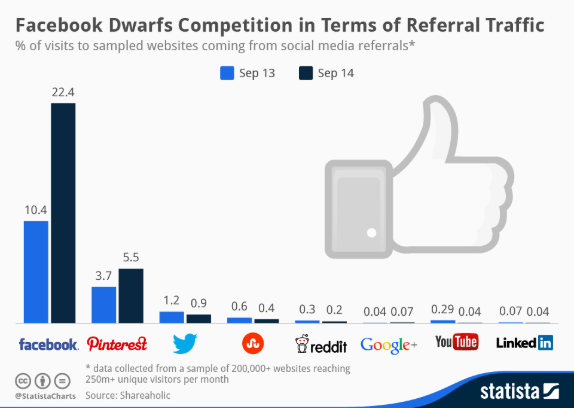
Image: Statista
Nevertheless, Facebook accounts for 50% of total social referrals and a farther 64% of overall social revenue, shows Business Insider.
In 2015, Facebook was responsible for influencing more than half - 52% - of consumers' online and offline purchases, shows DigitasLBi Commerce.
Twitter has proven itself a widely popular tool for people to recommend companies. SproutSocial shows that 53% of consumers recommend business organisation or products in tweets while a farther 48% follow through to purchase those products or services.
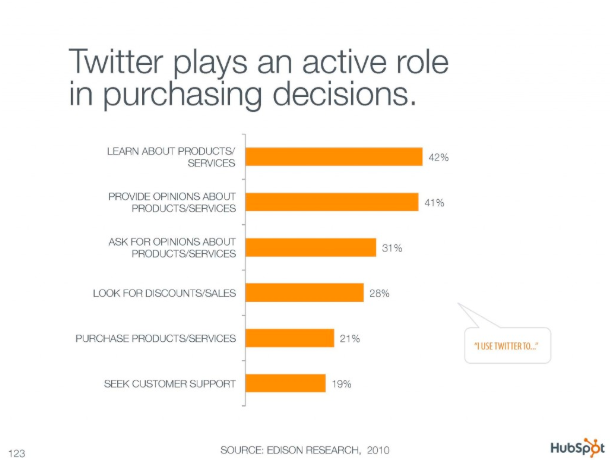
Image: Hubspot
Hubspot has shown Twitter users rely on the platform to larn about products and services, as well as provide their opinions.
Instagram is growing steadily. The social platform now boasts more than 500 million monthly agile users.
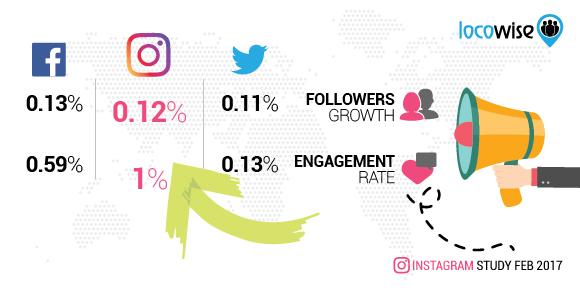
Image: Locowise
In 2017, its audience engagement charge per unit was lxx% college than Facebook and 669% greater than Twitter, shows Locowise.
The rise of the influencer
While knowing which platforms are the near productive employ of your advertisement revenue is helpful, it's probable more important to know exactly how constructive marketers are using these platforms to sell their wares.
Influencer marketing has get one of the near of import new tools for digital marketers.
A social media "influencer" is a person who has the power sway the decisions of their followers.
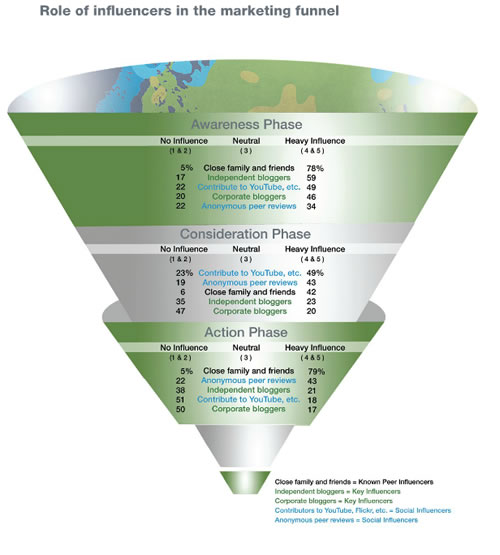
Image: Razorfish Marketing
Almost fifty% of Twitter users take made purchases every bit a direct result of a tweet from an influencer, according to a study from the Influencer Marketing Hub.
Those under the sway of influencers tend to trend younger, with 84% of millennials proverb user-generated content from strangers has at to the lowest degree some influence on how they spend their coin, shows Gartner.

Paradigm: TheShelf
Influencers have had some bad press recently thank you to a rash of aspiring influencers ownership "imitation" followers in order to lie their way into paid relationships with brands.
Instagram is maybe the biggest stage for influencers and information technology has already started cracking down on those accounts trying to buy fake followers. This could go a long manner to increase the authenticity and validity of this marketing style.
Friends and family issue
While the role of the influencer tin can't be overstated in modern marketing campaigns, it's important to call up that at that place are more than traditional avenues of influence that all the same take an bear upon.
Our friends and family still have a lot of sway in our purchasing habits. Co-ordinate to Forbes, 81% of consumers' purchasing choices are influenced past their friends' posts on social media.

Epitome: Razorfish Marketing
Razorfish Marketing takes a closer look at this, demonstrating that our peers have a college influence closer to the bottom of the sales funnel.
This group of family members and close friends can impact brand affinity and our purchasing decisions. According to Razorfish, therefore, it behooves marketers to sympathize how these inner circles influence consumers.
Tell me your story.
Stories are an increasingly popular mode for people to share content throughout social media. As of June 2018, effectually 400 million people were actively using Instagram Stories every day, shows Statista. That's a growth of 300 million users since the characteristic launched in 2016.
Number of daily active Instagram Stories users from October 2016 to January 2019 (in millions)
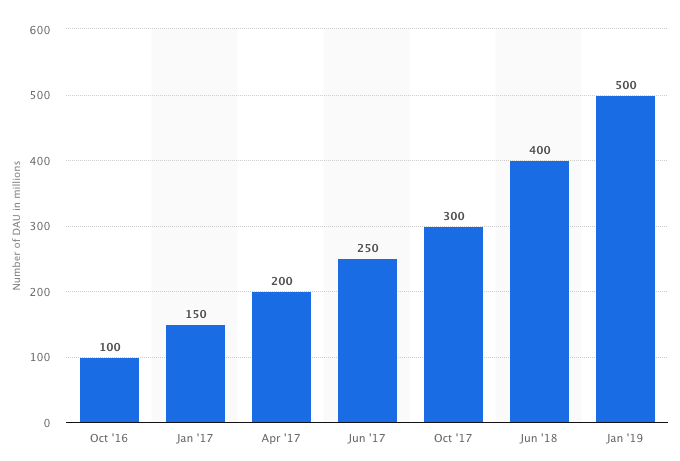
Image: Statista
This form of advertising has proven popular on other platforms as well. Snapchat, for 1, has demonstrated that people enjoy realistic, raw content.
This type of resources allows businesses to take people behind the scenes of their operations and demonstrate their personality and civilisation.
Facebook has more recently taken up the characteristic and has proven eager to promote it. Certain Facebook advertising objectives even allow marketers to utilise stories equally a placement.
On the other side, not-profits apply this to their advantage. They know it's easier to target brands on social media to aid them with their fundraising.
Become in now.
There are some signs that the social media marketing monster could be slowing down. According to the Daily Mail, around a third of millennials have permanently deleted their social media accounts.
Facebook and Twitter are usually the first to go, while more visually oriented platforms like Instagram and Snapchat tend to exist held on to a little longer.
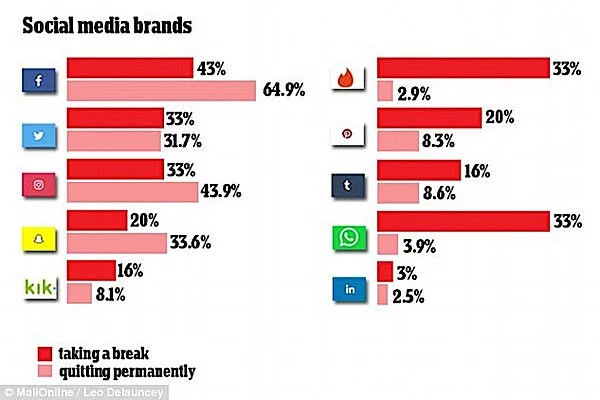
Epitome: The Daily Mail
Facebook kicked up some dust when it tried to coffin the Cambridge Analytica scandal. This has made users wary of trusting the social media giant.
Additionally, users tend to dislike the fact that so much of their information is existence stored - even if it isn't being sold directly to advertisers.
The 2018 Edelman Trust Barometer Special Report of Brands and Social Media showed that 71% of consumers desire brands to button social platforms to amend secure their personal information.
A further 49% say they aren't willing to sacrifice some information privacy in substitution for a more personalized shopping experience.
Other users have cited things like mental wellness concerns and over-commercialization equally their reason for cut the social media cord.
Studies have shown that younger generations experience 70% more depression and anxiety over the last 25 years. The report says social media use is deeply ingrained in these increases.
Meanwhile, the increment in contest has created a cocktail party issue in which brands are pushing more and more to be heard.
Almost two-thirds of millennials and Gen Zers say they're annoyed by make targeting in their social media feeds, while more than half take cut dorsum or stopped using the platforms all together equally a issue.
In one study, 74% of millennials and Gen Z said they're bellyaching by brand targeting in their social media feeds, and 56% accept cut back or stopped using social media entirely due to this.
Conclusion
Nosotros tin can run across that social networks take a large impact on how people spend their money these days. But the playing field is getting increasingly more than crowded.
Staying upwardly to engagement on the trends will remain important to success, only finding innovative, unobtrusive ways of getting your bulletin out there will probable testify necessary to futurity success.
Source: https://awario.com/blog/how-social-networks-influence-74-of-shoppers-for-their-purchasing-decisions-today/
Posted by: yarbroughseeck1975.blogspot.com


0 Response to "Who Does Morgan Stanley Use For Their Trust Services Today"
Post a Comment